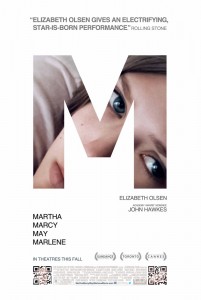 A lingering psychological thriller about a young girl named Martha who is disoriented after escaping from a cult, Martha Marcy May Marlene is a true break-out movie. It's an escape for actress and Elizabeth Olsen from being immediately associated with her famous twin sisters, and a near-perfect dash out of indie film obscurity for writer/director Sean Durkin, who makes this film his debut.
Like an American film directed by Cache and Funny Games director Michael Haneke, Martha Marcy May Marlene is sure to leave award-season audiences with questions about its story and subsequently its integral creative parts.
A lingering psychological thriller about a young girl named Martha who is disoriented after escaping from a cult, Martha Marcy May Marlene is a true break-out movie. It's an escape for actress and Elizabeth Olsen from being immediately associated with her famous twin sisters, and a near-perfect dash out of indie film obscurity for writer/director Sean Durkin, who makes this film his debut.
Like an American film directed by Cache and Funny Games director Michael Haneke, Martha Marcy May Marlene is sure to leave award-season audiences with questions about its story and subsequently its integral creative parts.
I sat down with Durkin and Olsen in a roundtable interview to discuss the ideas behind their film, the collaborative process that helped Martha reach the big screen, and what movies influenced this unique horror movie.
Martha Marcy May Marlene opens in Chicago on October 28, 2011.
It's not that often that we get to see a character upfront like this. We're not sure what's going on in her mind. You said you loved this character.
Elizabeth Olsen: I think there's a habit for people to quickly diagnose characters, and she was someone I didn't want to do that with. I thought I could get behind her from a not so critical way. I thought that she needed that type of approach for other people to not quickly condemn her or judge her. That was one of the first things that I reacted to do, to do it justice. And that there was a possibility of hope. As an audience member, I get really bored when it feels like only doom can happen. I thought that if you could create this inner struggle, that there is this drive to get better, or this drive to learn, than that to me is more interesting than just being a victim.
Could you explain a little bit behind your partnership with Antonio Campos? You produced "Afterschool" for him. What's your collaborative process like?
Sean Durkin: He and I and our other partner started making shorts together. We'd switch off producing. We'd work together on editing, script-writing. And when we got out of school we started a production company. We decided that were going to help each other and support each other through it. We did this whole system where one of us would be working while the other two were writing. We shared everything evenly. Antonio probably wrote forty drafts of Martha. They produced the movie, and got it made.
I thought it was really unsettling moving back and forth between the two families, in a sense that asked, "What's being said about this family, as opposed to this one?"
Durkin: I didn't want anyone to be purely good or purely bad. Because that's not how it is. But you take the scene when Louisa Krause's character Zoe is in bed after Martha has gone through the initiation, and it's probably the most loving that anyone has been to her in the whole movie. Then you go to the other side, where Martha's sister doesn't know how to open up. She's like, "Here's your tea. Here's your juice. Talk to me." There's no warmth. Everyone is sort of doing the best they can, and not knowing when they are harmful. I think that's how people are outside of these conditions.
Olsen: It's also important for the audience to be able to see what positive things the cult can offer - the sense of community, the sense of everyone having a purpose, the sense that we share everything. I think when we understand those things, we can understand why someone might be attracted, or stay.
Durkin: That was important to me. You don't have chanting. It's this nice vibe that you get. I really wanted it to be her perspective and her point of view and her experience. You can understand when she's falling in.
You have this element of people being manipulated by people of varying degrees of good and bad intentions.
Olsen: For me, the way that I react most to that comment with Martha is that there is this weird feeling in society today that if you don't graduate from high school, or college, if you don't have a direct path, then what are you good for? I think for Martha, it's that she got out of high school and wasn't sure what she was good at or what she wanted. She just became someone who was looking for a place to belong. For me, that's how I respond to it.
Were there any psychological conditions that you studied or researched for this role?
Durkin: Not besides people who had been through these experiences. I never studied anything clinical. One way after spending time with people who went through these experiences, and trying to understand their emotion, one way that it was easy for me to grasp it was to compare it to domestic abuse, alcoholism, drug abuse, etc. A daily level thing. I never studied it beyond human emotion, and how those things affect relationships. And how people deal with people in those relationships.
Olsen: I never wanted it to be clinical, but there is something that I could initially understand when I was at the lake house, this sense of paranoia. It wasn't so much a sense of paranoia like, "You're imagining things," but it was really just, "Where does that genuine fear come from?" To make that as real as possible was important to me.
Speaking of a sense of fear, would you talk a little bit about the aesthetic of the film? The tone? Polanski, Haneke?
Durkin: The aesthetic started with the desire to have things look worn, like the farm itself. We wanted the film itself to have that sort of feel. We tried to figure out what that would be. We eventually came to the idea by underexposing. The film look was one thing, and we just decided that you always wanted to be able to see through the window to the outside, or the outside back into the house. And just always have those layers there. It just sort of went from there. Visually, with the camera we wanted to be able to use all styles, but have a pacing. The consistency would be in the pacing, but use hand-held, dolly, zoom, to help the performance at that time. But when you have sound, there are things that specific. And you build on it, and then you go. We didn't have a plan for music, but our sound editor began to build these tones, and music grew out of those tones. The party scene works just like that - create the experience Martha has, and then everything comes together.
Can you talk about where she ends up at the end of the movie?
Olsen: I never think of stories beyond the framing of the way their told. What happens in the future happens in the future, I have no idea. But ultimately, I don't know.
Speaking about the ending, was there any debate as to how and when you'd end the film?
Durkin: It's always been a topic of discussion, but it's always been the same. That's how it's been.
Were there any films that you watched or music you listened to when preparing for the role?
Olsen: There wasn't anything specific that I was trying to draw on, but I did watch Images, and from watching that, I understood Sean's aesthetic a little more.
Durkin: It was less to do with the content or the performance, or just the idea of sharing films that I watch.
Olsen: For me, the script supervisor I was working with told me about Holy Smoke by Jane Campion with Harvey Keitel and Kate Winslet.
